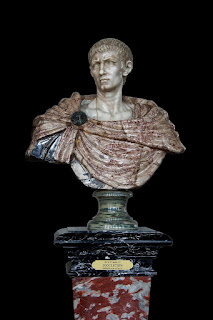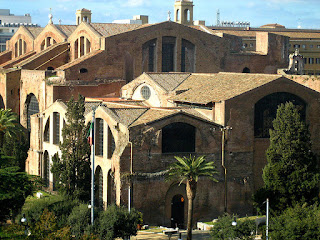Restored stability but launched cruel purge
 |
| Diocletian was from a humble family in what is now Solin in Croatia |
He was given the full name Gaius Aurelius Valerius Diocletianus Augustus according to official inscriptions. He ruled as Diocletian.
Diocletian was sole emperor, albeit initially with a disputed claim to power, until 286, joint-emperor until 293, and co-emperor in a tetrarchy until 305.
Born at Salona, a coastal town in Dalmatia (now Solin in Croatia) into a family of humble status in 244, Diocletian rose to power through his military background.
After climbing through the ranks, he became cavalry commander to the emperor Carus. After the death of Carus in 283, while on a campaign in Persia, power passed to his two sons, Numerian and Carinus.
When Numerian was allegedly murdered by his Praetorian Prefect, Arrius Aper, in 284, Diocletian was proclaimed as emperor by Numerian’s troops. He took it upon himself to avenge the death of Numerian by killing Aper with his own hands.
At the start, however, Diocletian’s power was restricted to the areas controlled by his army, thought to be Asia Minor and Syria. The remainder of the empire was loyal to Carinus.
 |
| Carinus, who Diocletian defeated to win power |
It was not long before Diocletian decided that the empire was too large to be governed by one ruler alone and in 286 he appointed Maximian, a trusted military colleague, as co-emperor. While Diocletian ruled in the east, Maximian was in charge of the west.
In 293 there was a further devolution as Diocletian introduced the Tetrarchy - rule of four - a system under which each emperor appointed a caesar - a junior co-emperor - of his choice, who would take over as emperor in the event of their deaths. Under the system, each co-emperor ruled over a quarter of the empire. The sharing of power, moreover, ensured that the death of one of the four would not lead to the upheaval that inevitably followed the death of a sole ruler.
These new caesars were Galerius in the east and in the west Constantius Chlorus, who ran Gaul and Britain and was the father of the future Constantine the Great.
 |
| An artist's reconstruction of the vast palace Diocletian built for himself in what is now Split in Croatia |
He reorganised the military and civil services and established new administrative centres in the four segments of the empire. The government of the empire worked more efficiently, although the creation of new layers of bureaucracy alongside the military campaigns came at a cost, as did the construction of a colossal palace complex in Dalmatia, so vast it today accounts for about half of what is known as the ‘old town’ in Split. His new tax system was seen as more equitable, but taxes were generally higher.
Diocletian is also known for instigating the Diocletianic Persecution, which was the last and most severe persecution of Christians in the history of the empire.
Although there was a persecution under Nero in around 64AD, for most of the first 250 years of the religion’s history, Christians had mostly been able to live in the Roman Empire in relative peace, go about their business and even attain positions of responsibility.
 |
| Christians were frequently made to fight for their lives against lions during the Diocletianic Persecution |
In 303, the co-emperors issued a series of edicts rescinding Christians' legal rights and demanding that they comply with traditional religious practices. Later edicts demanded universal sacrifice, ordering all inhabitants to sacrifice to the gods.
Galerius, who succeeded Diocletian in 305, continued the persecution until 311. It is estimated that between 3,000 and 5,000 Christians were executed over the eight years of the purge, although the objective of annihilating Christianity was not achieved. The creation of so many martyrs actually strengthened the Christian church.
Diocletian had abdicated in 305, in poor health, retiring to his palace in Split. He spent much of his remaining years gardening, rejecting a suggestion by Maximian that he should return to politics. He died in 313.
 |
| The Roman columns in front of the Basilica of San Lorenzo is the best known Roman relic in Milan |
The capital of the Western Roman Empire, from which Maximian ruled, was Mediolanum, the ancient city where Milan now stands. It was during Maximian’s reign that the population of Mediolanum grew from around 40,000 to more than 100,000, establishing it as one of the major cities on the Italian peninsula. Most of the Roman ruins still visible in Milan today are located between Piazza San Sepolcro (near the Duomo) and Corso Magenta. Among the most well-preserved examples of Roman construction in Milan can be found at the Basilica of San Lorenzo, in front of which is a colonnade of 16 Corinthian columns which were previously part of a second-century pagan temple. The Basilica of Sant’Ambrogio contains the so-called ‘Tomb of Stilicho’, thought to contain the sarcophagus of Flavius Stilicho, a high-ranking Roman general.
 |
| The ruins of the Baths of Diocletian are part of a complex that includes the Basilica of Santa Maria degli Angeli e dei Martiri |
The name of Diocletian is preserved in the Baths of Diocletian in Rome, built between 298 and 306 and the largest of the imperial baths, originally commissioned by Maximian. The baths occupy high-ground on the Viminal hill, the smallest of the seven hills of Rome, near what are today the Piazza della Repubblica and Termini rail station. They served as a bath for residents of the Viminal, Quirinal and Esquiline quarters. The excavation is one of the most accessible in Rome and requires about an hour and a half to look round.
Also on this day:
1851: The birth of Queen Margherita of Savoy
1902: The birth of World Cup-winning goalkeeper Giampiero Combi
1914: The birth of fashion designer Emilio Pucci
1978: The death of artist Giorgio de Chirico
Home






